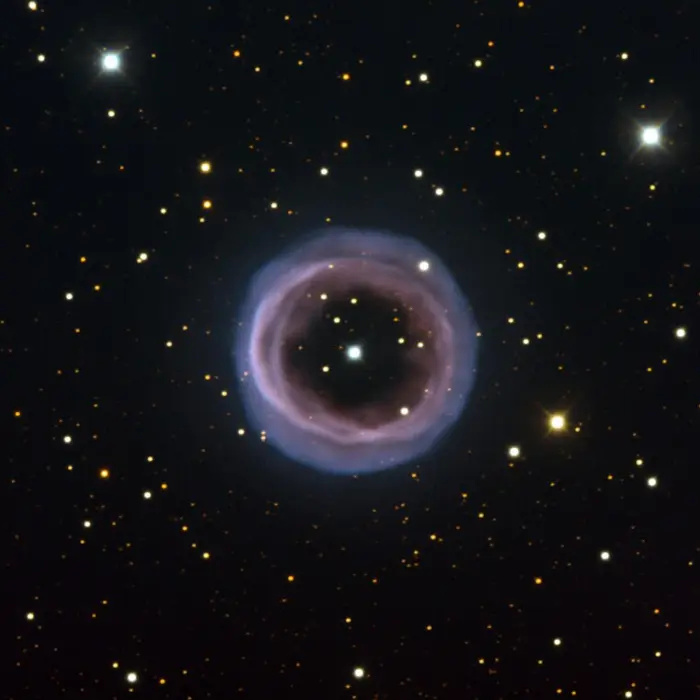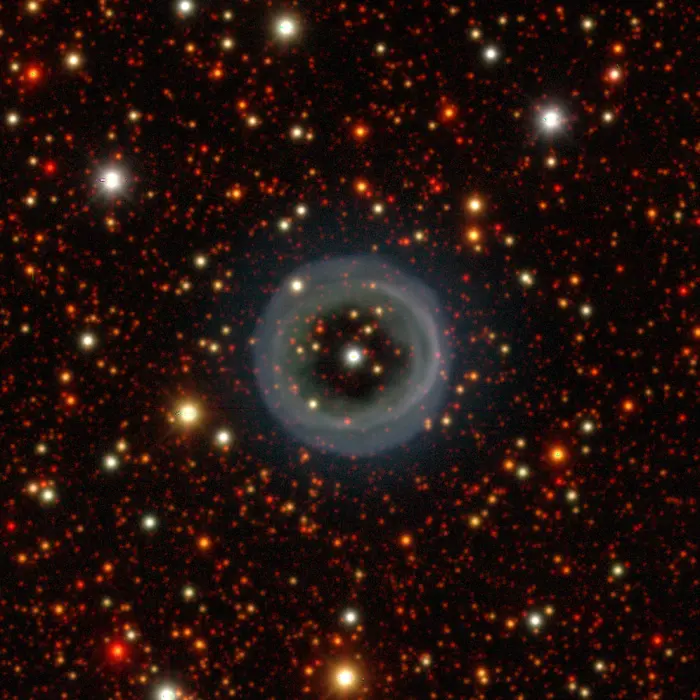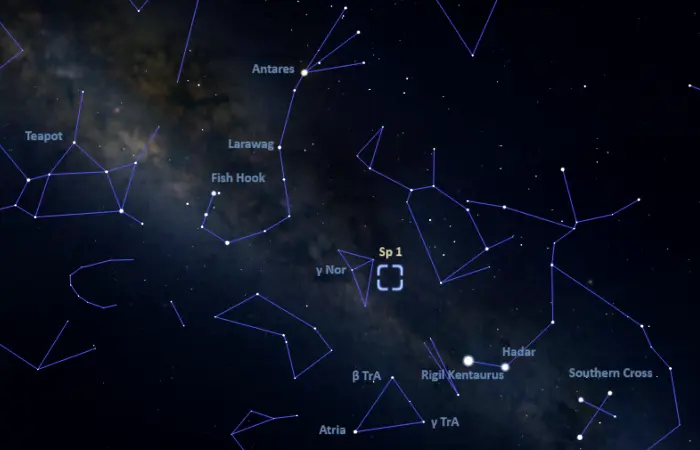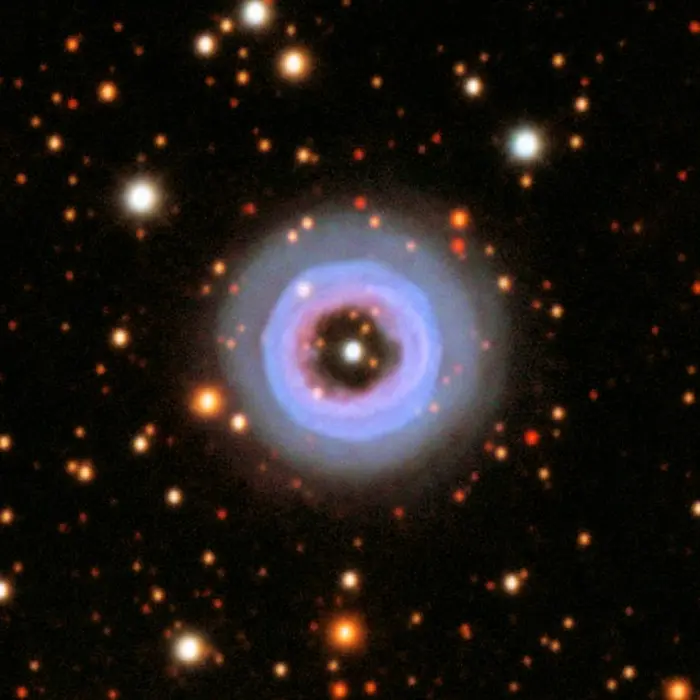The Fine Ring Nebula (Shapley 1) is a planetary nebula located approximately 4,900 light-years away in the southern constellation of Norma (the Level). It has an apparent magnitude of 12.6 and an apparent size of 1.1 arcminutes. It was discovered by the American astronomer Harlow Shapley in 1936.
Like all planetary nebulae, Shapley 1 formed when an aging star expelled its outer layers into space. The glowing shell of ejected material is ionized by the radiation of the hot stellar remnant at the centre of the nebula. The expanding shell will eventually dissipate into the interstellar medium and the stellar remnant will cool and stop giving off enough energy to ionize the expanding gas cloud.
The annular planetary nebula has an estimated age of 8,700 years. The nebula’s central star is known to be a binary star system in a close orbit. The binary star shines at magnitude 14 and was discovered spectroscopically in 1988. The star system has an orbital period of only 2.9 days. The interaction between the central white dwarf and its orbiting companion shapes the expelled material.

The hazy and aptly named Fine Ring Nebula, shown here, is an unusual planetary nebula. Planetary nebulae form when some evolved stars, having expanded into a red giant phase, expel a shell of gas as they evolve into white dwarfs. Most planetary nebulae are either spherical or elliptical in shape, or bipolar (featuring two symmetric lobes of material). But the Fine Ring Nebula — captured here by the ESO Faint Object Spectrograph and Camera mounted on the New Technology Telescope at the La Silla Observatory in Chile — looks like an almost perfect circular ring. Astronomers believe that some of these more unusually shaped planetary nebulae are formed when the progenitor star is actually a binary system. Planetary nebulae are shaped by the complex interplay of many physical processes. Not only can these celestial objects be admired for their beauty, but the study of precisely how they form their striking shapes is a fascinating topic in astronomical research. Image credit: ESO (CC BY 3.0)
The circular appearance of the Fine Ring Nebula is at odds with the presence of a binary system. Binary central stars are expected to produce aspherical nebulae.
The Fine Ring Nebula does not appear bipolar like many other objects of this kind. However, this is believed to be due to its position with respect to Earth; we see the binary system directly and the system’s orbit is perpendicular to Earth. The bluish outer halo is believed to be a flat equatorial ring, not a sphere.
The nebula appears as a diffuse ring with bright filaments superimposed upon it that give the appearance of two rings. The rings appear brighter in the western portion of the nebula. Astronomers have discovered a prominent bow shock west of the nebula, indicating that the expanding nebular material is interacting with the surrounding interstellar medium.
A 2011 study presented a detailed spatio-kinematical analysis of the nebula. Based on deep imaging with the 3.6 m ESO New Technology Telescope (NTT), modelling revealed Shapley 1 to be a bipolar, axysymmetric nebula seen almost exactly pole-on. The researchers, led by D. Jones of the European Southern Observatory (ESO) in Chile, found that the symmetry axis of the model nebula is almost perpendicular to the central binary system’s orbital plane.
Aspherical nebulae are thought to be formed by close binary central stars. Only a handful of planetary nebulae with central binary systems are known. Astronomers have suggested that many planetary nebulae that appear ring-like from our perspective – including the famous Ring Nebula in the constellation Lyra and the Helix Nebula in Aquarius – may in fact be bipolar in morphology and have symmetry axes inclined to the plane of the sky.

Fine Ring Nebula (PN Sp 1, RCW 100) with DECaPS DR2, image Credit: DECaPS / Legacy Surveys / D. Lang (Perimeter Institute), NERSC (CC BY 4.0)
Location
The Fine Ring Nebula can be found using the bright stars of the constellations Centaurus, Scorpius and Triangulum Australe. The triangle of Triangulum Australe points in the direction of the nebula, which lies on the imaginary line drawn from Rigil Kentaurus (Alpha Centauri) to Larawag (Epsilon Scorpii).
The nebula appears next to the faint constellation figure of Norma, whose brightest star, the orange giant Gamma2 Normae, shines at magnitude 4.02. Shapley 1 lies about 5 degrees west-northwest of the supergiant Gamma1 Normae (mag. 4.98).

The location of the Fine Ring Nebula (Shapley 1), image: Stellarium
At declination -51° 31’, the Fine Ring Nebula is visible from locations north of the latitude 38° N, but it never rises high above the horizon for observers in the mid-northern latitudes. It is best seen from the southern hemisphere.
The best time of the year to observe the Fine Ring Nebula and other deep sky objects in Norma is during the month of July, when the constellation appears higher above the horizon in the early evening.
Fine Ring Nebula – Shapley 1
| Constellation | Norma |
| Object type | Planetary nebula |
| Right ascension | 15h 51m 40.9510318656s |
| Declination | −51° 31′ 28.545826008″ |
| Apparent magnitude | 12.6 |
| Apparent size | 1.1’ |
| Distance | 4,900 light-years (1,502 parsecs) |
| Radius | 0.8 light-years |
| Names and designations | Fine Ring Nebula, Shapley 1 (Sp 1), ESO 225-2, Henize 2-137 (Hen 2-137), PLN 329+2.1, PK 329+02 1, PN G329.0+01.9, ARO 518, VV’ 127, VV 75, Sa 2-127, RCW 100, GSC2 S230232312032, IRAS 15479-5122, IRSV 1548-5120, 2MASS J15514094-5131285, TIC 280080580, UCAC2 9536571, UCAC3 77-261751, UCAC4 193-120336, Gaia DR2 5982072132545824128, Gaia DR3 5982072132545824128 |

The Fine Ring Nebula (Sh 1), image credit: Giuseppe Donatiello (CC BY-SA 4.0)